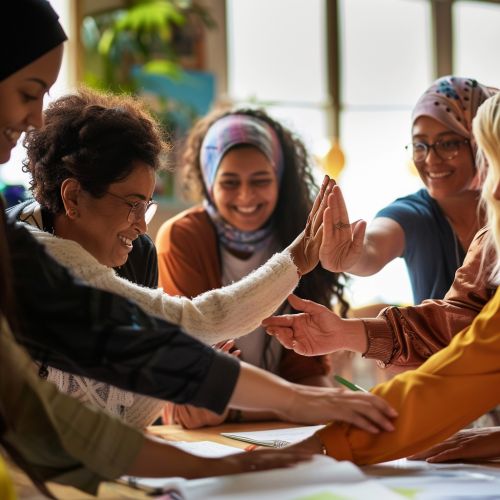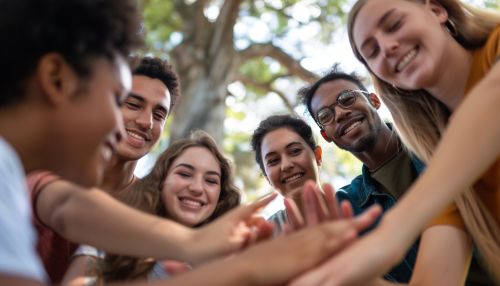Intergroup Contact Theory: Difference between revisions
(Created page with "== Introduction == Intergroup Contact Theory is a social psychological concept that explores how interactions between members of different groups can reduce prejudice and improve intergroup relations. The theory posits that under certain conditions, direct contact between members of different groups can lead to a reduction in intergroup bias and the promotion of more harmonious relationships. This theory has been extensively studied and applied in various contexts, incl...") |
No edit summary |
||
| Line 25: | Line 25: | ||
Support from authorities, institutions, or social norms is crucial for the success of intergroup contact. When leaders and institutions endorse and facilitate intergroup interactions, it legitimizes the contact and encourages positive behavior. This support can come in the form of policies, programs, or public statements that promote inclusivity and diversity. | Support from authorities, institutions, or social norms is crucial for the success of intergroup contact. When leaders and institutions endorse and facilitate intergroup interactions, it legitimizes the contact and encourages positive behavior. This support can come in the form of policies, programs, or public statements that promote inclusivity and diversity. | ||
[[Image:Detail-92337.jpg|thumb|center|People from different ethnic backgrounds engaging in a collaborative activity.|class=only_on_mobile]] | |||
[[Image:Detail-92338.jpg|thumb|center|People from different ethnic backgrounds engaging in a collaborative activity.|class=only_on_desktop]] | |||
== Mechanisms of Change == | == Mechanisms of Change == | ||
Latest revision as of 23:58, 14 June 2024
Introduction
Intergroup Contact Theory is a social psychological concept that explores how interactions between members of different groups can reduce prejudice and improve intergroup relations. The theory posits that under certain conditions, direct contact between members of different groups can lead to a reduction in intergroup bias and the promotion of more harmonious relationships. This theory has been extensively studied and applied in various contexts, including racial, ethnic, religious, and socio-economic groups.
Historical Background
Intergroup Contact Theory was first proposed by Gordon Allport in his seminal work "The Nature of Prejudice" (1954). Allport suggested that prejudice could be reduced through direct contact between groups under specific conditions. These conditions include equal status between groups, common goals, intergroup cooperation, and support from authorities, law, or customs. Allport's hypothesis laid the foundation for subsequent research and theoretical developments in the field of intergroup relations.
Key Conditions for Effective Intergroup Contact
Equal Status
One of the critical conditions for successful intergroup contact is the perception of equal status among group members. When individuals from different groups perceive each other as equals, it reduces power imbalances and fosters mutual respect. Equal status can be achieved through institutional support, shared roles, or environments that emphasize equality.
Common Goals
Shared objectives or goals that require cooperation between groups can facilitate positive intergroup interactions. When groups work together towards a common goal, it encourages collaboration and reduces the focus on group differences. This condition helps to build a sense of unity and collective identity.
Intergroup Cooperation
Cooperative activities that require interdependence between groups are essential for reducing prejudice. When groups must rely on each other to achieve a goal, it promotes positive interactions and reduces negative stereotypes. Cooperative learning environments, team-building exercises, and joint problem-solving tasks are examples of activities that can foster intergroup cooperation.
Support from Authorities
Support from authorities, institutions, or social norms is crucial for the success of intergroup contact. When leaders and institutions endorse and facilitate intergroup interactions, it legitimizes the contact and encourages positive behavior. This support can come in the form of policies, programs, or public statements that promote inclusivity and diversity.


Mechanisms of Change
Intergroup Contact Theory identifies several psychological mechanisms through which contact can reduce prejudice and improve intergroup relations. These mechanisms include increased knowledge, reduced anxiety, and enhanced empathy.
Increased Knowledge
Direct contact with members of different groups can lead to increased knowledge and understanding of the outgroup. This knowledge helps to dispel myths and stereotypes, reducing prejudice. Exposure to diverse perspectives and experiences can challenge preconceived notions and promote more accurate perceptions of the outgroup.
Reduced Anxiety
Intergroup contact can reduce anxiety and fear associated with interactions between groups. Familiarity with outgroup members can alleviate concerns about negative evaluations or hostile behavior. Reduced anxiety facilitates more relaxed and open interactions, contributing to positive intergroup relations.
Enhanced Empathy
Empathy, or the ability to understand and share the feelings of others, is a crucial outcome of intergroup contact. Positive interactions with outgroup members can foster empathy by highlighting shared human experiences and emotions. Enhanced empathy leads to greater compassion and reduces the likelihood of discriminatory behavior.
Applications and Implications
Intergroup Contact Theory has been applied in various contexts to address issues of prejudice and discrimination. Some notable applications include educational settings, workplace diversity programs, and community initiatives.
Educational Settings
In educational settings, intergroup contact can be facilitated through integrated classrooms, multicultural curricula, and collaborative learning projects. Schools and universities can create environments that promote positive interactions between students from diverse backgrounds, fostering mutual respect and understanding.
Workplace Diversity Programs
Organizations can implement diversity and inclusion programs that encourage intergroup contact among employees. These programs may include diversity training, team-building activities, and mentorship opportunities. By promoting positive interactions in the workplace, organizations can reduce bias and create a more inclusive culture.
Community Initiatives
Community-based initiatives can also leverage intergroup contact to address social divisions. Programs that bring together individuals from different racial, ethnic, or religious groups for joint activities, such as community service projects or cultural exchanges, can promote social cohesion and reduce prejudice.
Criticisms and Limitations
While Intergroup Contact Theory has garnered significant support, it is not without criticisms and limitations. Some scholars argue that the theory may not fully account for the complexities of intergroup relations and that contact alone may not be sufficient to reduce prejudice in all contexts.
Contextual Factors
The effectiveness of intergroup contact can be influenced by various contextual factors, such as the historical and socio-political context, the nature of group relations, and the presence of structural inequalities. These factors can impact the outcomes of intergroup contact and may require additional interventions to address underlying issues.
Quality of Contact
The quality of intergroup contact is crucial for achieving positive outcomes. Superficial or negative interactions can reinforce stereotypes and exacerbate prejudice. Therefore, it is essential to ensure that intergroup contact is meaningful, positive, and sustained over time.
Generalization of Effects
Another limitation is the potential difficulty in generalizing the positive effects of intergroup contact to the broader group. Positive interactions with individual outgroup members may not always translate to more favorable attitudes towards the entire outgroup. Researchers emphasize the importance of repeated and varied contact experiences to enhance generalization.
Future Directions
Future research on Intergroup Contact Theory continues to explore new dimensions and applications. Some emerging areas of interest include virtual intergroup contact, intersectionality, and the role of emotions in intergroup relations.
Virtual Intergroup Contact
With the rise of digital communication, virtual intergroup contact has become an area of interest. Online platforms and social media provide opportunities for individuals from different groups to interact and share experiences. Researchers are investigating the potential of virtual contact to reduce prejudice and promote positive intergroup relations.
Intersectionality
Intersectionality, or the interconnected nature of social categorizations such as race, gender, and class, is another emerging area of research. Scholars are examining how multiple social identities intersect and influence intergroup contact experiences. Understanding intersectionality can provide a more nuanced perspective on intergroup relations and inform more effective interventions.
Role of Emotions
Emotions play a significant role in intergroup relations, and researchers are exploring how different emotional responses impact the outcomes of intergroup contact. Positive emotions, such as empathy and compassion, can enhance the benefits of contact, while negative emotions, such as fear and anger, can hinder progress. Investigating the role of emotions can help develop strategies to foster positive emotional experiences during intergroup interactions.
Conclusion
Intergroup Contact Theory provides a valuable framework for understanding and addressing prejudice and discrimination. By identifying the conditions and mechanisms through which contact can improve intergroup relations, the theory offers practical insights for promoting social cohesion and inclusivity. While challenges and limitations remain, ongoing research and applications continue to advance our understanding of intergroup contact and its potential to create a more equitable and harmonious society.
